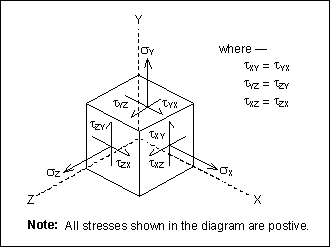How Stress Components Relate to Textbook Examples
If you are trying to relate the stress results or stress measures reported by native mode Structure to textbook examples, you may find that Creo Simulate expresses stress component direction somewhat differently than your textbook.
The diagram below describes the directions of the stress components in a standard textbook application.

The following items explain the relation between the textbook definition of stresses and the values reported by Structure:
• Textbooks commonly denote normal stresses by the symbol  and a subscript indicating the plane on which the stress acts. A normal stress is positive if it is tensile. Structure denotes the normal stresses in Structure as Stress XX, Stress YY, and Stress ZZ.
and a subscript indicating the plane on which the stress acts. A normal stress is positive if it is tensile. Structure denotes the normal stresses in Structure as Stress XX, Stress YY, and Stress ZZ.
 and a subscript indicating the plane on which the stress acts. A normal stress is positive if it is tensile. Structure denotes the normal stresses in Structure as Stress XX, Stress YY, and Stress ZZ.
and a subscript indicating the plane on which the stress acts. A normal stress is positive if it is tensile. Structure denotes the normal stresses in Structure as Stress XX, Stress YY, and Stress ZZ.• Textbooks commonly denote shear stresses by the symbol  and two subscripts. The first designates the plane on which the shear stress acts and the second indicates the coordinate axis to which it is parallel.
and two subscripts. The first designates the plane on which the shear stress acts and the second indicates the coordinate axis to which it is parallel.
 and two subscripts. The first designates the plane on which the shear stress acts and the second indicates the coordinate axis to which it is parallel.
and two subscripts. The first designates the plane on which the shear stress acts and the second indicates the coordinate axis to which it is parallel.The sign of a shear stress depends on the normal of the plane on which it is acting. If the outward normal is positive, the shear stress is positive when it points in the positive direction of the coordinate axis which it parallels. If the outward normal is negative, the shear stress is positive when in points in the negative direction of the coordinate axis which it parallels.
Structure denotes the shear stresses as Stress XY, Stress XZ, and Stress YZ. The other three shear stress components follow these equivalent relations:
◦ Stress XY = Stress YX
◦ Stress XZ = Stress ZX
◦ Stress YZ = Stress ZY